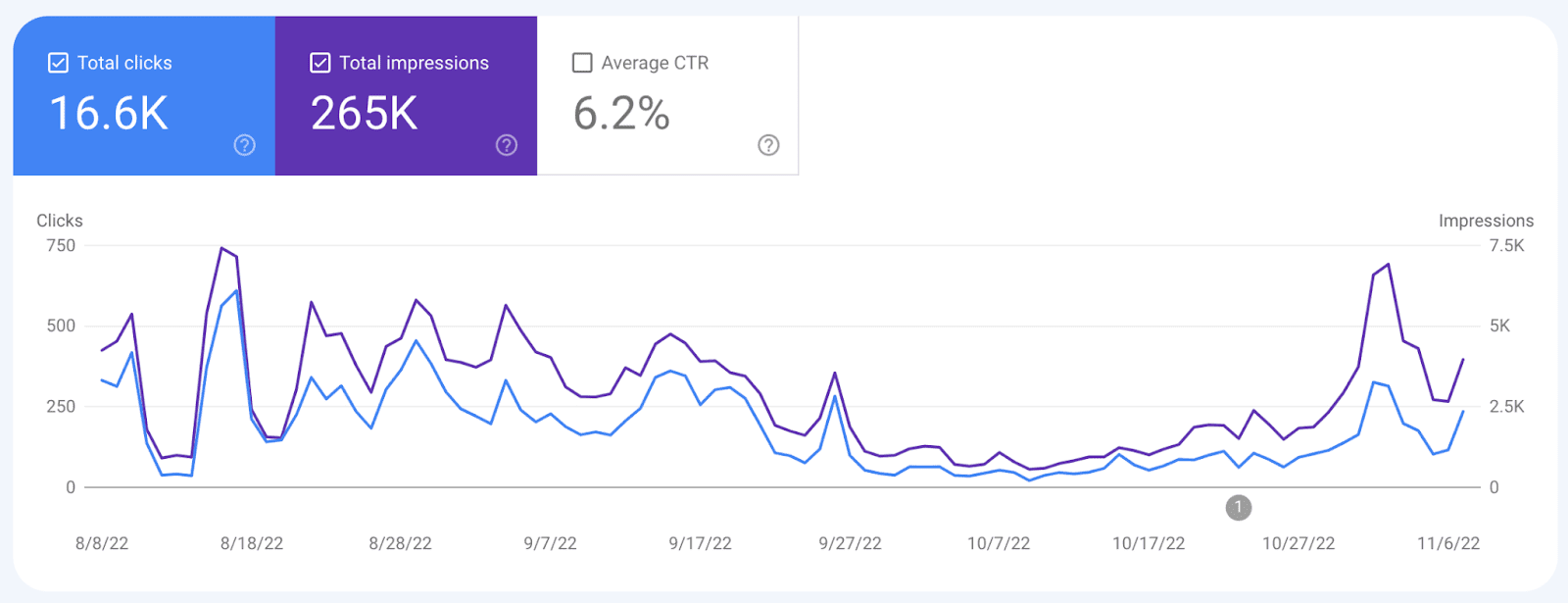“Why did my organic traffic drop?!” is a panicked question that you never want to be asking. But traffic drops happen to the best of us.
The Forge and Smith site has had two organic traffic drops in the last eight years, so we know exactly what you’re going through. You feel like you’re doing everything right and then suddenly… *poof!* Half your traffic or more is gone. No apology, no note.
It’s easy to rush to the conclusion that you’ve been penalized by Google, but penalties are far rarer than you might think. You have to be up to some seriously nefarious, black-hat SEO business to get deindexed.
So let’s take a few deep breaths. If you’re looking at Google Analytics and your organic traffic has made a sharp drop, you need to figure out why it happened.
We’ll walk through the main causes of an organic traffic drop, and recommend fixes to help you increase your organic search traffic.
Post Contents
- Why did my organic traffic drop?
- 12 Ways to Find and Fix a Traffic Drop
- 1. Check Your Website
- 2. Check Google Search Console
- 3. Check Google Analytics
- 4. Seek Google Algorithm Updates
- 5. Investigate Google Bugs
- 6. Check Google Trends
- 7. Use an SEO Tool
- 8. Look Up Your Product or Service
- 9. Review Deleted Content
- 10. Analyze Major Website Changes
- 11. Look for Migration Mistakes
- 12. Review Recently Blocked Content
- How to Increase Traffic After a Drop
Why did my organic traffic drop?
First let’s make sure we’re on the same page: we’re talking about a sharp drop in organic search traffic only.
- That means traffic earned from search engines through regular SEO and content marketing (not through ads, backlinks, email campaigns, or social media)
- A drop is different from a steady decline over several months – although many of the same SEO tactics will help you fix that!
Organic traffic is usually pretty steady for most small businesses. You have a business blog, you’re publishing at least one new article each month, and keeping the rest of your site well-optimized. In this scenario, you’ll only see minor monthly fluctuations or a steady increase.
If you’re more aggressive about your content marketing, you might see bumps in organic traffic every time you publish new content, and maybe even a larger increase each month.
Either way, a sudden drop means something big happened, and you should investigate ASAP!
Here are ten common reasons your organic search traffic dropped:
- Google released a broad core algorithm update, and your content was negatively impacted (most often relating to quality, speed, or trustworthiness)
- You deleted a piece of content that was earning a high volume of organic search traffic
- You significantly changed your site structure or a large volume of content (ie. redesigned your site, rewrote key pages, or deleted a bunch of old blog posts)
- A mistake was made while migrating to a new domain or undergoing a relaunch, and you now have a technical SEO error
- Your Google Analytics tracking code was altered and isn’t tracking properly, or a Google tool is experiencing a bug
- Your site has a technical issue that’s preventing traffic from actually getting to it, such as a server problem
- Your site has seasonal or timely content and the trend has changed
- A competitor is outranking you for the keyword(s) delivering your highest traffic volume
- You blocked content that was formerly indexed
- Your site has received a manual action (ie. a penalty) from Google for violating its terms
Losing a link from a high-authority site could make Google see you as less relevant and authoritative, and indirectly impact your organic traffic due to a lower ranking for a major query. So although website visits from backlinks are technically ‘referral traffic’ in Google Analytics, we’ll consider that an honorary 11th possible reason for lost organic search visits.
12 Ways to Find and Fix a Traffic Drop
We’ve listed the most likely reasons for organic traffic to tank. Now let’s dig deeper into where to look for problems, what they mean, and what to do about it.
1. Check Your Website
Make sure everything is in order as far as your hosting and server, security, and uptime. Look for notifications in your platform dashboard. Find out if any customers have complained about issues with the site.
Fix technical issues immediately, either through your web developer, IT department, or hosting company.
2. Check Google Search Console
Look for notifications about technical SEO warnings or errors. If your site is connected and verified, Google Search Console will let you know if pages are experiencing indexing problems, if you have server errors, if you have usability problems, and if you’ve received a dreaded manual action.
These notifications will explain what’s wrong and offer the ability to test fixes, but you’ll want to search the exact warning phrasing and find tips from experts on how to actually fix it. Here’s an amazingly thorough guide to most errors and warnings you’ll find in Google Search Console to help you get started.
3. Check Google Analytics
Make sure it’s accurately tracking traffic. Use the Realtime report to confirm if you’re getting website visits from organic search.
You can test this by doing a search for your business, then clicking to your website from the search results in one tab while viewing the report in another. (You may have to use incognito browsing, depending on your GA filters and settings.)

If you can’t see traffic when you know for sure you clicked to the site from organic search results, then you likely need to fix or replace your GA tracking code. Someone may have modified the site code while editing content, adding other marketing tracking codes, or configuring Google Tag Manager.
4. Seek Google Algorithm Updates
Search online to see if Google released a broad core algorithm update and if so, what it was focused on. If it was about content quality, page speed, questionable backlinks, or trustworthiness, you have your work cut out for you to improve your content or your website as a whole.
The site below experienced a Google traffic drop after an algorithm update.

5. Investigate Google Bugs
Search online to see if Google Search Console is experiencing a bug that impacts tracking website clicks. GSC bugs are fairly common, and the SEO community will have published numerous articles and tweets complaining about any known issue. Google Analytics is less likely to be buggy, but never say never.
6. Check Google Trends
Google Trends can help you see if topics that normally lead customers to your site have plummeted in interest, or if there’s a hot political, seasonal, or global topic that’s likely to have stolen your audience’s interest away from your content.
This is even easier to do if you can use an SEO tool to see which keywords drive the most traffic to your site each month, and plug those words into Google Trends. Speaking of which…
7. Use an SEO Tool
Tools like SEMRush or Ahrefs can help you see if you’ve experienced a drop in ranking for a valuable, high-traffic keyword. These tools let you sort your keywords by ‘difference’, which is a change in ranking. Reverse-order sorting will show you the keywords that have lost position.
A big drop in an irrelevant keyword is fine, and small fluctuations in relevant keywords are normal too. But if you see a drop for queries relating to your key products or services, you may have found the culprit. This is especially true if you spot a juicy keyword that has plummeted from page one to page two or lower.
In the example below, Forge and Smith has dropped from approximately position 8 to position 9 for ‘website design company’, which the tool estimates delivers 3.5% of our monthly traffic.

This isn’t one of our top keywords, and the estimated percent of our monthly traffic isn’t high enough that this loss would cause a sudden organic traffic drop. But it does illustrate how to find the source of lost traffic using keywords!
Using this information you can see which URL was ranking for that search, and determine whether you accidentally undid existing optimizations by editing content, Or, perhaps there’s something technically wrong with the page.
8. Look Up Your Product or Service
Do an online search as if you were a customer, and see if you’ve dropped in ranking – either dropping off page one or falling lower on page one. This is a workaround if you don’t have access to an SEO tool (although many offer limited free accounts!).
The reason for your organic traffic drop may not be something wrong with your page or strategy at all, but instead be that a competitor did something awesome and is now outranking you.
For example, if you were previously in the top three search results and are now further down, that can actually have a HUGE impact on organic traffic. Stats have shown that the top three results earn around 55% of all search clicks, so even if you’re still ranking on page one but lower down, that could mean someone else is now getting a big portion of traffic that was previously yours.
9. Review Deleted Content
Did you delete a key piece of content that was earning organic search traffic? If so, did you redirect it properly? Should you consider bringing it back, or is it okay that you lost the traffic to delete irrelevant content and improve your site’s user experience?
You can check the popularity of pages using Google Analytics. Navigate to Behaviour > Site Content > Landing Pages and set the segment to organic traffic.

10. Analyze Major Website Changes
There are plenty of good reasons to change your website.
Small businesses often experience growth in our offerings, our messaging, and our teams, all of which mean website updates. Plus, a stagnant website is going to slowly lose traffic over time. You just need to keep in mind that any major change to your site is likely going to have an impact on your organic traffic.
The next time Google’s crawler bots come to your site, it will be a whole new world to their AI brains. Context and relevance previously known to Google will not match up, and the result can be a sudden, drastic plummet in ranking.
Here are the most common content-related causes of a traffic drop:
- Significantly editing the content on a high-ranking, high-traffic page
- Editing the content across a large number of pages
- Deleting a large volume of content
- Changing your site structure (hierarchy of content, navigation)
- Changing your location and contact details
These massive changes are typical for a full website redesign, and can cause your traffic to drop off. If you’ve taken proper SEO precautions during the process, a post-launch drop is almost always temporary, while Google re-evaluates your content and relevance.
Below is an example of an organic traffic drop after a full redesign and restructure.

Make sure that you’re always making strategic, data-driven decisions about your content. Work with experts in both user experience and SEO on a website redesign, so they can help you make the best decisions when it comes to your content and technical SEO.
Any deleted content should always have proper redirects set up. This way you retain at least some of the SEO value.
And keep in mind that proximity to a user plays a huge role in local SEO, so if you change your address anywhere you should expect a change in ranking and traffic. That includes discrepancies between your website address and Google Business Profile – Google cross-checks this information everywhere that your business is listed.
If you experience a traffic drop after making major website changes, the best thing to do is focus on producing awesome content.
- Focus on quality rather than quantity, but do make sure you are regularly publishing optimized content
- Know what your audience wants, and write on those topics
- Create the right content for the right search intent
- Know your keywords (especially any you lost traction for after launch)
- Don’t give up – it can take many months to see results
11. Look for Migration Mistakes
Speaking of setting up proper redirects, lots can go wrong during a website migration that can cause your traffic to drop.
I won’t go into detail because that’s a whole other article – plus the experts at Moz have it covered in their Website Migration Guide. The important takeaway is that if you’re doing any kind of migration listed below (or others found in the guide), you should work with someone experienced in technical SEO or better yet, a team that includes developers and an SEO consultant:
- Changing domain
- Changing website platform
- Re-launching a site with different content and menus
- Merging sites
- Adding e-commerce
- Integrating martech platforms
- Changing or expanding regions
- Changing or adding languages
Each of these changes has many moving parts that impact how Google sees your site (or can’t see it anymore).
12. Review Recently Blocked Content
Just like deleting content, blocking content from indexing is definitely going to have an impact on your organic traffic.
Indexing is the process through which search engines crawl your site, analyze your content, and list you in their index. When we type a search into Google, we’re searching Google’s index.
With WordPress sites, you can easily control which content is indexed and which is not using the Yoast SEO plugin. If someone on your team recently changed Yoast settings and blocked high-volume content from indexing, on purpose or by mistake, that could cause a sudden organic traffic drop.
Blocking content from indexing isn’t a bad thing! Not every part of our websites needs to be in search results. In fact, there are lots of areas of your site that you’re better off blocking.
Some examples include private internal resources, PDFs, blog tags, author bios, taxonomies that filter content, and WordPress components that have their own URL but make up one piece of a larger page.
How to Increase Traffic After a Drop
Whether your traffic has dropped, slowly declined, or is just stagnant – that’s not what you want to see.
If you want to jumpstart your organic traffic, you can work on 10 basic SEO strategies:
- Learn about keywords and search intent
- Focus on consistently producing high-quality content that showcases your trustworthiness and expertise
- Maintain a great user experience
- Stay on top of website security and technical SEO
- Keep mobile friendliness in mind
- Evaluate your link structure
- Learn about image optimization
- Check that your contact details are consistent everywhere that your business appears online
- Amplify your content on social media
- Write enticing meta descriptions
We’ve actually got an article that explains each of these steps in more detail – read How to Increase Organic Traffic.
Now that you know multiple ways to investigate an organic traffic drop, you’ll be in a much better position to find the source and start fixing the problem. When in doubt, ask a professional SEO for help!





